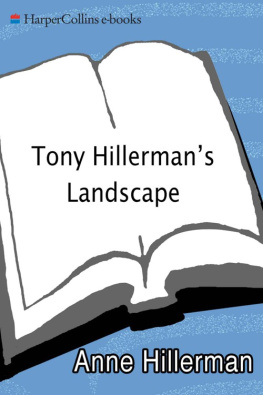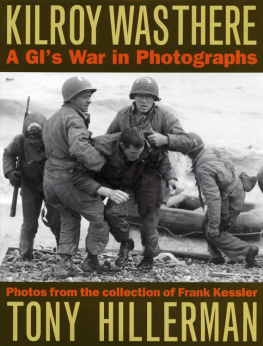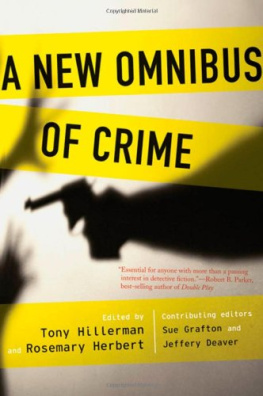Tony Hillermans Landscape
%">
On the Road with an American Legend
%">
Anne Hillerman
Photographs by Don Strel

%">
Contents
On the Road with Chee and Leaphorn: A Daughters Recollections
The Blessing Way (1970)
Dance Hall of the Dead (1973)
Listening Woman (1978)
People of Darkness (1980)
The Hopi Books: The Dark Wind (1982), The First Eagle (1998), and Skeleton Man (2004)
Indian Country and Beyond: The Ghostway (1984), Talking God (1989), and The Sinister Pig (2003)
Skinwalkers (1986)
A Thief of Time (1988)
Coyote Waits (1990)
Sacred Clowns (1993)
The Fallen Man (1996)
Hunting Badger (1999)
The Wailing Wind (2002)
The Shape Shifter (2006)
Why Los Ranchos? by Tony Hillerman
%">

%">

White House Ruins and petroglyphs at Canyon de Chelly, Arizona
%">
C OMES A TIME, comes a man who can read the landscape, and by it come to know a people, then tell their story, and enlighten the world to a whole new way of life.
Tony Hillerman had certainly come to understand the culture of Navajo people, a culture found in and tied to the land where Navajos dwell.
Who better than Tony Hillerman could read the landscapes and by it come to understand the ways of a people, which makes him a son of the Navajo people?
What is presented here, in this book, are some of the places where Tony Hillermans stories about Navajos are found, heard, seen, and lived; man"Navajos call them sacred lands.
In the land are found Navajo people, and Tony Hillerman found them. No story can be told about Navajo people without referring to the land where they are.
In the same way, I hope you come to find a culture, a way of life, and a people in the story told through the landscapes depicted in this book.
Better yet, I invite you to come and see us on our sacred lands.
Dr. Joe Shirley, Jr.
President, The Navajo Nation

Actor Wes Studi, Tony Hillerman, Dr. Joe Shirley Jr., President of the Navajo Nation and his wife, Vikki Shirley, at the Notable New Mexican dinner, which honored Hillerman in Albuquerque in 2004.

Badlands near Tuba City
%">
B ROWSERS EXPECTING THIS book to be devoted to page after page of lovely vistas, dazzling sunsets, snowcapped peaks, and so forth will be not surprised by what they find. I dont think the photography will disappoint them.
Don Strel, a former college art professor, museum director, and a much published photographer, first suggested the project. His wife, a nonfiction writer and my senior daughter Anne, provided a wealth of ideas.
Our plan was to take readers with Jim Chee and Joe Leaphorn, the two Navajo detectives in my mystery stories, to Dinetah , a translation of Land of the Din and homeland of the Navajos since long before Christopher Columbus was born. So Anne spent countless hours poring through the eighteen tales of Navajo tribal police activities, looking for scenic or otherwise notable places where old Lieutenant Leaphorn and young Officer Chee had found clues to the crimes and nabbed the criminals who beset the Din.
That done, Anne obtained a contract from Harper Collins, my publisher for the latest of those novels, to use excerpts describing the scenery, explaining what had happened at the sites of the photographs you will soon be looking at. The text sometimes talks about what had transpired in the mythical past to cause that mountaintop to be rated as holy ground. Or why stepping on the pattern running water had left in a certain streambed was taboo among traditional Navajos and that, therefore, the suspect the FBI agents were looking for probably was not the man they needed to be seeking.

Mount Taylor as the Navajos may have seen it returning from Bosque Redondo
Alas, there isnt a way to show in photographs the key cultural beliefs that made me rate traditional Navajos the worlds most humane culture. If the crime Joe Leaphorn must solve involves talk of witchcraft, he will be looking for someone who puts wealth ahead of helping his neighborsa sure sign of evil since the First Man of Navajo culture emerged from the flooded Fourth World into this glittering world. The Navajo version of their genesicins relates that First Man was a witch himself. When he realized that he had left his medicine bundle and all the magic within in the flood below, he told a heron to dive down and recover it for him. But he warned the bird not to mention the evil witchcraft materials it contained. Just tell them it is the way to get rich.
I think that explains why the culture of the people whose home is Between the Sacred Mountains puts giving ahead of receiving and why accumulating wealth without being generous is a serious social failing. The tribe demonstrated their belief in that value system after the Civil War, when the United States government sent a delegate to the Bosque Redondo concentration camp where the tribe had been imprisoned. The delegate described to the assembled tribesmen the glories of the fertile and well-watered land by the Arkansas River in Indian Territory, where their crops and sheep would fare much better, and life would be much easier for them, far better than the rocky, barren, and almost waterless land they had occupied.
Heres how Barboncito, one of the Din leaders, responded: What we want is to be sent back to our own country. Even if we starve there we will have no complaint to make.
Tribal leaders signed a peace treaty on June 1, 1868. Escorted by four companies of U.S. cavalry, the Long Walk home began for the ten-mile-long column of men, women, and children. The marchers averaged walking ten miles per day to cross more than 300 miles, taking what remained of their cattle and sheep with them. On July 5, they crossed Tijeras Canyon and looked down from the next ridge across the little town of Albuquerque by the Rio Grande. Beyond, eighty miles to the west, stood the peak of Turquoise Mountain outlined against the horizon, one of the four sacred mountains marking the borders of their homeland.
One of the commanders of the Army troops who escorted the Navajos wrote about the moment in this report to Lt. Gen. William T. Sherman, who had headed the commission that freed the tribe from captivity: We paused for a rest there, and when the Navajo saw their mountain on the western horizon, the whole column broke out in shouts and tears of joy.
But how can you show that in a photograph?
Tony Hillerman
Summer 2007

Anne looks over the Chimney Rock landscape north of Shiprock, New Mexico.
%">

















